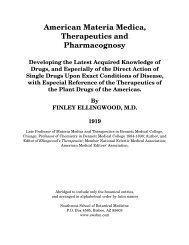SCARLET FEVER. Synonyms.—Scarlatina; Scarlet Rash. Definition ...
SCARLET FEVER. Synonyms.—Scarlatina; Scarlet Rash. Definition ...
SCARLET FEVER. Synonyms.—Scarlatina; Scarlet Rash. Definition ...
Create successful ePaper yourself
Turn your PDF publications into a flip-book with our unique Google optimized e-Paper software.
Exciting Cause.—To Kitasato belongs the honor of discovering the<br />
specific cause, the bacillus pestis bubonicæ. This is a short bacterium,<br />
almost as broad as long. On entering the body, either by inoculation or<br />
by way of the digestive or respiratory tracts, it multiplies with great<br />
rapidity. It is found in the blood, in the internal organs, in the intestinal<br />
canal, lymphatic glands, and in great numbers in suppurating buboes.<br />
Outside the body it is found in dust and infected clothing and bedding<br />
of infected houses; it is also found in fleas, flies, rats, mice, cats, dogs,<br />
and other domestic animals. It is now believed that rats are the common<br />
carriers of this dread plague.<br />
Pathology.—Rigor mortis occurs early, and often there is elevation of<br />
temperature immediately after death. Petechiæ, ecchymoses, and<br />
carbuncles are generally found upon the skin. The lymphatic system is<br />
early affected, the lymph glands of the groin and axilla being the first to<br />
show evidence of the inflammation.<br />
Broncho-pneumonia is a common result, the lung tissues being involved<br />
more than in ordinary broncho-pneumonia. The spleen is soft and<br />
swollen, with hemorrhagic areas. The liver and kidneys also show<br />
degenerative changes.<br />
Symptoms.—Three varieties are recognized: (1) The bubonic; (2) The<br />
pneumonic; (3) The septicemic. The first named is the most frequent and<br />
typical.<br />
Four stages are given: (1) Invasion or prodromes; (2) Fever; (3)<br />
Localization, or development of the buboes; (4) Convalescence.<br />
Incubation.—This period lasts from twelve hours to seven or eight days.<br />
Invasion.—This stage begins suddenly, with dizziness, pain in the head<br />
and back, and with more or less depression; the patient is dull, eyes<br />
expressionless, and the mind is confused. When the patient attempts to<br />
walk, he staggers like a drunken man. There may be no distinct rigor,<br />
but chilliness occurs, with nausea and vomiting. Often diarrhea appears<br />
early. These symptoms last twelve, twenty-four, or thirty-six hours,<br />
when the second stage is ushered in.<br />
Fever.—This stage frequently commences with a chill, followed by a<br />
quick rise of temperature. The pain in the head and back increases; the<br />
The Eclectic Practice of Medicine - PART I - Infectious Diseases - Page 231

















